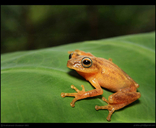|
Raorchestes luteolus (Kuramoto & Joshy, 2003)
Coorg Yellow Bush Frog | family: Rhacophoridae subfamily: Rhacophorinae genus: Raorchestes |
| Species Description: Mitsuru Kuramoto and S. Hareesh Joshy 2003. Two New Species of the Genus Philautus (Anura: Rhacophoridae) from the Western Ghats, Southwestern India. Current Herpetology 22(2): 51-60 | |
 © 2013 Prathamesh Ghadekar (1 of 3) |
|
|
|
Description Males are yellow during breeding season and cream in the non-breeding season. The pupil is golden and the eyes have a complete blue ring on the outer margins of the pupil (Gururaja et al. 2007). This species can be distinguished from the similar species R. travancoricus by having a pointed snout (vs. oval snout in R. travancoricus), rounded canthus rostralis (vs. indistinct), uniformly granular dorsum (vs. shagreened), yellowish sides (vs. light brown), and lack of a dark-brown streak on either side of the snout (vs. presence of dark-brown snout streaks) (Biju and Bossuyt 2009). Distribution and Habitat Country distribution from AmphibiaWeb's database: India
Life History, Abundance, Activity, and Special Behaviors Larva Trends and Threats Possible reasons for amphibian decline General habitat alteration and loss Comments This species was described by Kuramoto and Joshy (2003), as Philautus luteolus. Subsequently Philautus neelanethrus (described by Gururaja et al. 2007 from Shimoga District in Karnataka state) was synonymized with P. luteolus by Biju and Bossuyt (2009). This species was then transferred from the genus Philautus into the genus Raorchestes by Biju et al. (2010).
References
Biju, S. D., Shouche, Y., Dubois, A., Dutta, S. K., and Bossuyt, F. (2010). "A ground-dwelling rhacophorid frog from the highest mountain peak of the Western Ghats of India." Current Science, 98(8), 1119-1125. [link] Biju, S. D., and Bossuyt, F. (2009). ''Systematics and phylogeny of Philautus Gistel, 1848 (Anura, Rhacophoridae) in the Western Ghats of India, with descriptions of 12 new species.'' Zoological Journal of the Linnean Society, 155, 374-444. Das, I. (2004). Raorchestes luteolus. In: IUCN 2011. IUCN Red List of Threatened Species. Version 2011.1. www.iucnredlist.org. Downloaded on 05 October 2011. Gururaja, K. V., Aravind, N. A., Ali, S., Ramachandra, T. V., Velevan, T.P ., Krishnakumar, V., and Aggarwal, R. K. (2007). ''A new frog species from the central Western Ghats of India, and its phylogenetic position.'' Zoological Science, 24, 525-534. Kuramoto, M., and Joshy, S. H. (2003). ''Two new species of the genus Philautus (Anura: Rhacophoridae) from the Western Ghats, southwestern India.'' Current Herpetology, 22, 51-60. Originally submitted by: Kellie Whittaker (first posted 2010-06-22) Edited by: Kellie Whittaker, Michelle S. Koo (2022-08-18) Species Account Citation: AmphibiaWeb 2022 Raorchestes luteolus: Coorg Yellow Bush Frog <https://amphibiaweb.org/species/6262> University of California, Berkeley, CA, USA. Accessed Apr 19, 2025.
Feedback or comments about this page.
Citation: AmphibiaWeb. 2025. <https://amphibiaweb.org> University of California, Berkeley, CA, USA. Accessed 19 Apr 2025. AmphibiaWeb's policy on data use. |



 Map of Life
Map of Life